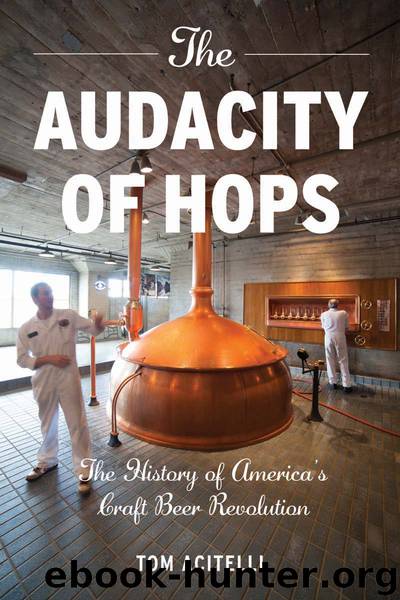The Audacity of Hops by Tom Acitelli

Author:Tom Acitelli
Language: eng
Format: epub, mobi
Publisher: Chicago Review Press
Published: 2013-09-05T16:00:00+00:00
*It turned out the brewery had, in fact, been employing union construction workers; it was just that the unions did not have enough work for them, so they took the brewery job on the side. (Per Hindy and Potter, Beer School, 171-72.)
ATTACK OF THE PHANTOM CRAFTS
Denver; St . Louis | 1994-1995
More people than ever, from the mob to the media, were paying attention to the American craft beer movement, and that included Big Beer. The wider industry had spent a generation ignoring it or, at best, treating it as a fad. The number of barrels produced by the largest breweries only grew, after all, through the 1980s as the number of breweries shrank dramatically. With market share increasing and competition decreasing, why fret some dreamers in sneakers in their rented warehouse space and glorified speakeasies? It wasn’t arrogance on the part of Big Beer; it was charts and graphs that showed clear trends through decades now—no matter how clever, creative, or just genuinely better tasting the craft start-ups were. For all the Sturm und Drang of the already storied sector, it still accounted for less than 3 percent of US beer sales by the 1990s.
Then 1992 rolled around. The productivity levels of Big Beer rolled back; the charts and graphs were no longer going inexorably upward. There were different causes, not least of which was the recession of the early 1990s and renewed competition from imports. It was around this time, too, that Big Beer turned to more aggressive marketing overseas, including in the recently liberated nations of Eastern Europe no longer behind the Iron Curtain. More than anything, it appears Big Beer simply overdid it with the domestic marketing and advertising and in the end ceded ground or lost it. Top industry analyst Bob Weinberg called the period from 1991 to 1995 “the brewing industry’s Vietnam,” when Big Beer could have enticed more consumers but instead stuck to what seemed tried-and-true measures. “I don’t know why the industry doesn’t aggressively campaign for intelligent drinking,” Weinberg told a reporter. “Less than half of the people who can drink legally, do. None of the brewers do this, however. They go after the twenty-one-to-twenty-four-year-olds instead, and that’s just preaching to the choir.” The advertising, so potently effective in the 1970s and 1980s, seemed to have run its course, and the overseas market was not going to pick up all of the slack. Where to next?
The name conjured up something ruggedly American: a wild, untamable animal; mountains meant to hold possibilities; a way away from cities and toward something new. In the spring of 1994, Anheuser-Busch debuted its Elk Mountain Ale, a red ale intended to compete, at least according to reports, with Coors’s Killian’s Irish Red, unveiled at the first Great American Beer Festival in 1982, and Miller’s Leinenkugel Red, spun from the Wisconsin regional that it had taken over in 1988.* But there was something about the earnestness with which Anheuser-Busch hawked Elk Mountain: its debut was pushed up several months, moving from the back burner at the St.
Download
This site does not store any files on its server. We only index and link to content provided by other sites. Please contact the content providers to delete copyright contents if any and email us, we'll remove relevant links or contents immediately.
| African | Asian |
| Canadian | Caribbean & West Indian |
| European | International |
| Latin American | Mexican |
| Middle Eastern | Native American |
| U.S. Regional |
Biscuits: A Savor the South Cookbook by Belinda Ellis(4289)
The French Women Don't Get Fat Cookbook by Mireille Guiliano(3604)
A Jewish Baker's Pastry Secrets: Recipes from a New York Baking Legend for Strudel, Stollen, Danishes, Puff Pastry, and More by George Greenstein(3544)
Better Homes and Gardens New Cookbook by Better Homes & Gardens(3523)
Ottolenghi Simple by Yotam Ottolenghi(3513)
Al Roker's Hassle-Free Holiday Cookbook by Al Roker(3498)
Trullo by Tim Siadatan(3378)
Bake with Anna Olson by Anna Olson(3355)
Hot Thai Kitchen by Pailin Chongchitnant(3320)
Panini by Carlo Middione(3248)
Nigella Bites (Nigella Collection) by Nigella Lawson(3171)
Momofuku by David Chang(3139)
Salt, Fat, Acid, Heat: Mastering the Elements of Good Cooking by Nosrat Samin(3106)
Modern French Pastry: Innovative Techniques, Tools and Design by Cheryl Wakerhauser(3073)
Best of Jane Grigson by Jane Grigson(2944)
Classic by Mary Berry(2940)
Solo Food by Janneke Vreugdenhil(2927)
Tapas Revolution by Omar Allibhoy(2924)
Ottolenghi - The Cookbook by Yotam Ottolenghi(2869)
